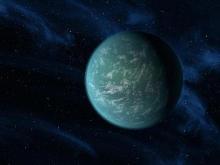Could it have aliens? And what would they be like?
NASA has discovered the most Earth-like planet found to date, some 600 light-years away. Kepler-22b is two and a half times larger than Earth, and orbits a star very much like our own sun. It has an average temperature of 72 degrees, warmer than that of our own planet's, which is about 60 degrees.
Kepler-22b was spotted by the Kepler space telescope, which is not able to tell us whether or not the planet has an atmosphere, or what the planet's mass might be. It is a slight red flag that Kepler-22b is twice the size of Earth. This means that it may turn out to be a gas giant, a planet like Neptune or Jupiter with a small rocky core surrounded by gases. But in the best-case scenario, it could turn out to be a high-gravity ocean planet.
(One interesting consequence of having spotted Kepler-22b is that SETI is back, because the U.S. Air Force is paying to have it scan Kepler-22b for aliens! The University of California had to cut SETI's funding earlier this year, due to budgetary problems. But in the wake of donations from an online fundraiser as well as a significant grant from the US Air Force, SETI is back up and running. And thanks to the Kepler project, SETI now has some solid targets for study.)
From a strictly science-fiction-y perspective, Kepler-22b is probably too far away to visit, barring the existence of a significantly faster-than-light drive. Its distance means that even if you could travel at the speed of light, you would reach the planet in 600 years. Double the speed of light, and you're talking 300 years.
This is within potential range of a Generation Ship, of course: a ship whose centuries-long destiny is to travel to a new planet. A ship that could travel at twice the speed of light would reach Kepler-22b within 100 generations, roughly the difference between us and the first working steam engine.
As for the residents of Kepler-22b, assuming it is an ocean planet with a high gravity, they might not be too different from the middle range of Earth's ocean life. Friction is a much more meaningful force than gravity, for life forms which have the advantage of the buoyancy of water.
Anthropologically speaking, it has largely been assumed that a technological culture is unlikely to develop from an aquatic species. The environment isn't as rich in tools or varied in challenges as a terrestrial environment, and it lacks permanence. It's hard to develop stone age technology if you have nowhere to put your stones when you aren't using them.
